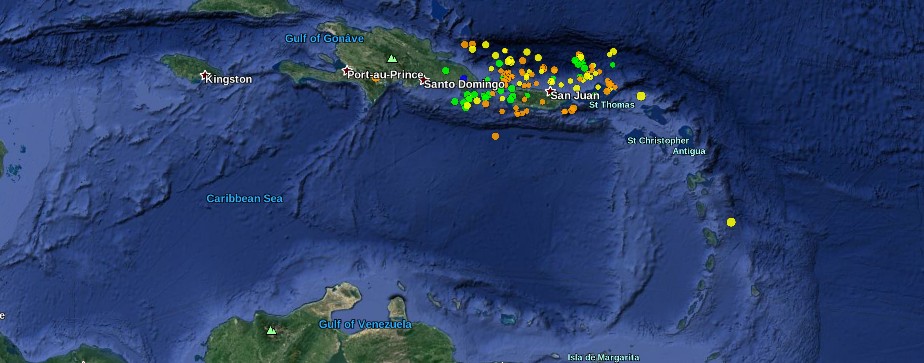Caribbean region long overdue for a magnitude 8.0 earthquake

The Trinidad-based Seismic Research Centre (SRC) of the University of the West Indies (UWI) has warned the Caribbean countries to be prepared for a major quake, the Jamaica Observer said in an article published today.
The center recorded a total of 8 M4+ earthquakes since June 9, 2016, the strongest of which was a M4.8 earthquake that occurred northwest of Antigua on August 8, 2016.
Last year, SRC said the 12th January 2010 Haitian earthquake that destroyed the poorly constructed structures causing the deaths of more than 230 000 persons should have been the wake-up call for a fundamental shift in regional mechanisms for coping with seismic hazards.
"This has not happened in the Caribbean, and the region continues to be extremely vulnerable to seismic events," it said in a news release adding that research suggests the region is capable of generating an earthquake of magnitude 6.0 or larger every 3 – 5 years.
"Of more concerns, we are long overdue for a magnitude 8.0 earthquake, which has 32 times more energy than the Haiti event."
"In light of these sobering facts, it is imperative for the region to move expeditiously towards building resilience to such events. We must develop, legislate and enforce Building Codes using up-to-date seismic hazard maps based on the latest available science. Preparedness measures at the individual levels are insufficient, and greater efforts are needed to facilitate self-resilience."
Although earthquakes around Puerto Rico and the Dominican Republic are fairly common, we should add their 141 M2.5 – 4.6 earthquakes recorded by the USGS over the past 30 days to the 8 M4+ earthquakes recorded by the SRC since June 9, 2016.

M2.5 earthquakes recorded between July 23 and August 23, 2016, by the USGS. Orange markers show earthquakes that occurred in the last 24 hours, yellow in the last week, white are older than one week. Credit: USGS
The Puerto Rico Trench is associated with the most negative gravity anomaly on earth, -380 milliGal, which indicates the presence of an active downward force. It is the deepest part of the Atlantic Ocean, with water depths exceeding 8.4 km (5.2 miles), according to NOAA.
Trenches in the Pacific are located in places where one tectonic plate subducts or slides under another one. The Puerto Rico Trench, in contrast, is located at a boundary between two plates that slide past each other with only a small component of subduction.

Bathymetry of the northeast corner of the Caribbean plate. The main topographic features of this area include: the Lesser Antilles volcanic arc, the old inactive volcanic arc of the Greater Antilles (Virgin Islands to Hispaniola), and the Caribbean and North American oceanic plates. Note that the Puerto Rico Trench, a deep trough where the North American plate slides past and underneath the Antilles, becomes deeper and wider north of Puerto Rico. A limestone platform is tilted toward the trough in this area. Other large-scale features are the Muertos Trough, where Caribbean plate crust may slide under the Antilles, and the Virgin Islands and Anegada Trough, whose origin is unknown. Credit: USGS
Puerto Rico, the Virgin Islands, and eastern Hispaniola are located on an active plate boundary zone between the North American plate and the northeast corner of the Caribbean plate. The Caribbean plate is roughly rectangular, and it slides eastward at about 2 cm/yr (0.8 inches per year) relative to the North American plate. The region has high seismicity and large earthquakes that can generate devastating tsunamis.
Examples include a magnitude 7.5 earthquake centered northwest of Puerto Rico in 1943, and magnitude 8.1 and 6.9 earthquakes north of Hispaniola in 1946 and 1953, respectively. Historically, other large earthquakes have also struck the area, such as one in 1787 (magnitude~8.1), possibly in the Puerto Rico Trench, and one in 1867 (magnitude~7.5) in the Anegada Trough.
Immediately after the 1946 earthquake, a tsunami struck northeastern Hispaniola and moved inland for several kilometers. Some reports indicate that nearly 1 800 people drowned. A 1918 magnitude 7.5 earthquake resulted in a tsunami that killed at least 91 people in northwestern Puerto Rico. Eyewitness reports of an 1867 Virgin Islands tsunami gave a maximum wave height of >7 m in Frederiksted, St. Croix, where a large naval vessel was left on top of a pier.
Essentially, all of the known causes of tsunamis are present in the Caribbean – earthquakes, submarine landslides, submarine volcanic eruptions, subaerial pyroclastic flows into the ocean, and major tsunamis called teletsunamis, NOAA said. Because of its high population density and extensive development near the coast, Puerto Rico has a significant risk for earthquakes and tsunamis.

Location of earthquakes as a function of depth and size in the northeastern Caribbean. Barbed lines represent subduction zones; arrows represent the direction of relative plate motion; dashed lines represent migration of the line of volcanoes from an older line to a newer one farther west, and (-)g represents the location of the largest minimum gravity anomaly on Earth. Credit: NOAA
The tectonic setting of the Puerto Rico Trench is sometimes compared to that of the Sumatra subduction zone, the site of the earthquake that triggered the devastating Indian Ocean tsunami of December 2004. This similarity has caused great interest in the assessment of potential tsunami hazard to the United States east coast and the northeastern Caribbean from a large subduction-zone earthquake along the Puerto Rico Trench, the USGS said back in 2007.
Featured image: M2.5+ earthquakes between July 23 and August 23, 2016, colorized by depth. Orange: 0 – 33 km, Yellow: 33 – 70 km, Green 70 – 150 km, Blue: 150 – 300 km. Credit: USGS, Google

9/10/2017 – Angie de Anda Printed @ 8:13 PM PST